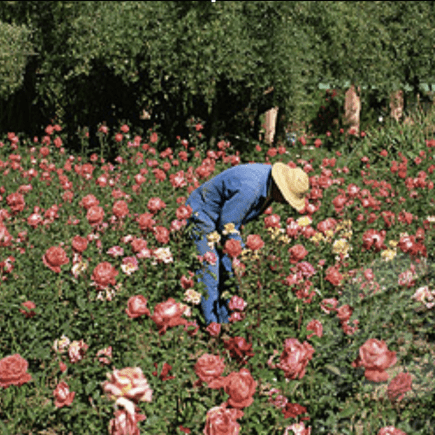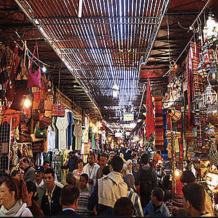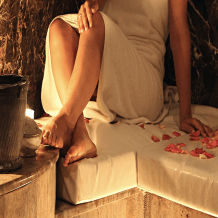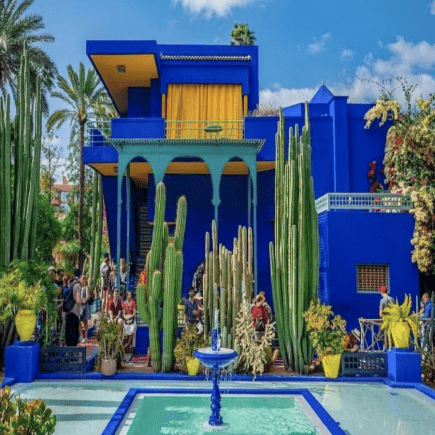
Moroccan Gardens Tour, Discover Moorish, Andalusian, Herbal & Medicinal Gardens
Discover the tradition and history of Moroccan Gardens on a special guided tour written by horticultural and garden enthusiasts. A Gardens of Morocco Private Tour offers the perfect opportunity journey through the Maghreb’s most private and public green spaces and places. Visiting Gardens of Morocco is an ideal way to connect with fellow garden enthusiasts. Discover ancient cities led by licensed historical guides, gardens with expert Gardeners, Botanists, Nurserymen and Herbalists Morocco’s ancient culture is steeped in rich traditions not to be missed. Great pleasure of the senses will be experienced on an exotic tour that includes Morocco’s Imperial Cities and rural regions. Morocco is home to Moorish, Andalusian, Herbalist and Medicinal Gardens.
Highlights of Morocco’s Top 8 Leading Gardens: Moorish, Andalusian, Herbal & Medicinal Gardens that will be explored on a Gardens of Morocco Tour are:
Exotic Gardens at Sidi Bouknadal Rabat – In 1951, Marcel François, a French horticultural engineer acquired 4 acres of flat and exposed land in Sale, Morocco. Ten years later he opened to the public his childhood dream, Bouknadel Exotic Gardens, a horticultural and artistic achievement, listed among the wonders of nature and now classified as a national cultural heritage site since 2003. The gardens are a composition of exuberant creativity and technical ability. Francois, traveled all over the world collecting plants as far away as China, South Asia, the Savannah, Congo, Japan, Brazil and Polynesia. He then set about duplicating these gardens at Sidi Bouknadal by incorporating landscape, habitat and climate in his plant compositions. The gardens are divided into three areas: a reception area, horticultural production area and finally, by far the most impressive, the garden area. All through the garden there are secret passages, an aviary, waterfalls, swamps, pools, fountains, bridges and walkways to lead you through the various gardens.
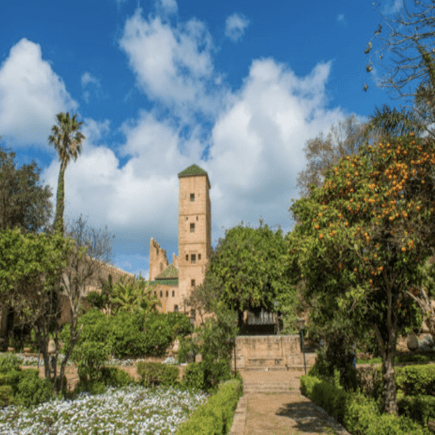
Andalusian Gardens at Kasbah Oudaia in Rabat
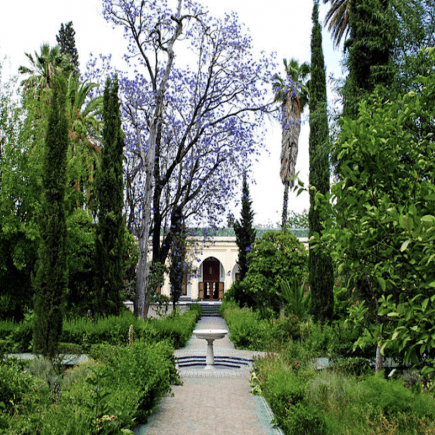
Dar Batha Garden & Museum in Fes
The Musee Dar el-Batha offers up a great collection of pottery, leatherwork, wood, books and manuscripts from the nineteenth century centered around a green spacious courtyard. The Batha Andalusian Garden boasts a three-hundred year old Quercus Rotundifolia, Washington Fifera, Cycas Revolta and Moroccan fountains.The Batha Garden is a serene escape from the bustling medina in Fes. It is also utilized each June by the Fes Festival of Sacred World Music whereby various world music groups perform.
Roman Ruins in Volubilis
The breathtaking archaeological site of Volubilis, also referred to as Oualili, was once occupied by the Romans. Volubilis has been recognized by UNESCO as a world heritage site and gained international acclaim when Martin Scorsese made it a feature location for his film, The Last Temptation of Christ. Discover the fascinating Roman ruins adorned with beautiful mosaics and colorful tiles depicting Roman mythology. The ruins are spread out across several acres and what remains visible is several fragments of wall, parts of massive columns, the capitol, the basilica, and a triumphal arch. The ruins reveal how the Roman Empire transformed the original Carthaginian settlement into a typical Roman city complete with mansions, a town center, a triumphal arc, and temples devoted to Roman gods.
The Yves Saint Laurent, Majorelle Gardens in Marrakech
The Majorelle Gardens, previously the Jardin Bou Saf, bears its name from its original creator, Jacques Majorelle, the French expatriate artist who was born in Nancy, France, in 1886. Jacques Majorelle was the son of the celebrated Art Nouveau furniture designer Louis Majorelle. In 1947, the son opened his gardens to the public and, during this time, also painted a magnificent ceiling at La Mamounia, a five-star hotel with exquisite gardens and the place where Alfred Hitchcock wrote The Birds. Jacques Majorelle studied at the École des Beaux Arts in Nancy in 1901 and in 1919 went to Marrakech to recover from heart problems. He built the garden during those years, using a special blue color that he used extensively in the garden and that is named after him, Majorelle blue. Majorelle returned to France in 1962 after a car incident and died later that year of complications from his injuries. The atmosphere of the Majorelle Gardens evokes a sense of peace in a garden designed, composed and colored like a painting. Moorish and Art Deco inspired structures with their bold color palettes are assembled among a vast, opulent array of exotic plants and trees collected from the far reaches of the world. The courageous use of color, the famous Majorelle blue paint used in his architectural design enlivens the garden and acts as a strong backdrop to his plant collection of over 1800 types of cacti, 400 species of palms and other rare varieties of the time. This bold action revolutionized the way in which gardens were to be viewed.
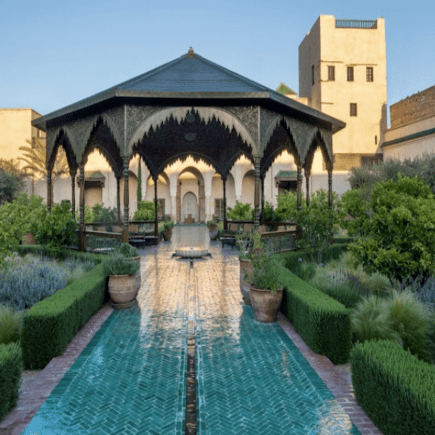
Le Jardin Secret Marrakech
A charming garden well appointed in the Mouassine district of the Marrakech medina. The origins of the complex date back to the Saadian Dynasty, more than four hundred years ago. Rebuilt in the mid-Nineteenth century at the behest of an influential Caid of the Atlas Mountains, Le Jardin Secret has been the home of some of Morocco and Marrakech’s most important political figures. As the result of a recent renovation; Le Jardin Secret is now part of the great tradition of stately Arab-Andalusian and Moroccan palaces.
Saffron Gardens in the Ourika Valley
Herbal Tea Tasting at the Saffron Gardens – A Moroccan Doctor founded the Saffon Gardens, a six-hectare project to grow saffron and exotic fruit. The area surrounding the saffron fields is a working farm with French goats for milk and many species of plants and trees.The annual harvest by the local Berber women in the village yields only 5 kilos of saffron that is certified by the International Certification Lab in France. There is a small museum explaining the process of growing, harvesting, trimming and drying the saffron.
